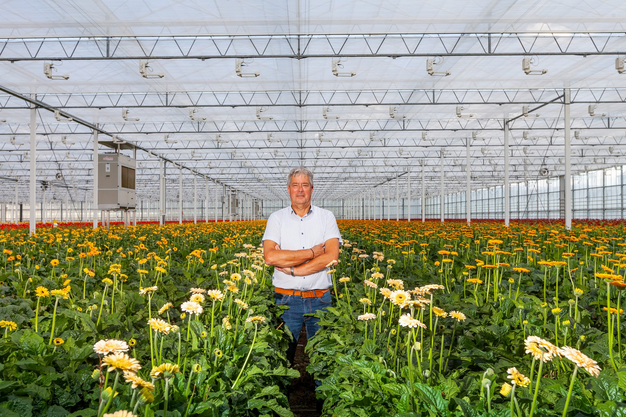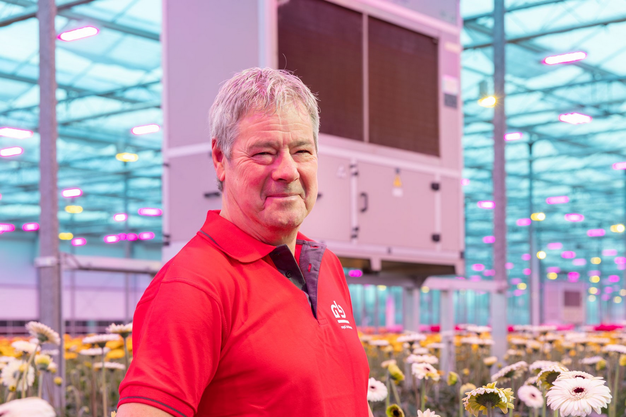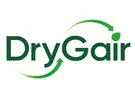According to DryGair, for the past 8 years, Eef Zwinkels has been a key figure behind the popularization of dehumidification systems in Dutch horticulture. His role as Royal Brinkman's DryGair Product Specialist, as well as his past as a tomato grower and water treatment specialist, have made him one of the industry's go-to guys when it comes to humidity control, as stated by DryGair.
DryGair spoke with Zwinkels at GreenTech Amsterdam, in 2024, touching on his experience and expertise, the popularity of dehumidification systems, such as DryGair, and the future he sees for closed environment horticulture.
From tomato grower, to water specialist, to dehumidification expert
"My roots are in tomatoes. My father was a tomato grower," says Zwinkels. "In 1977, we built a new facility, with a plastic greenhouse. Back then, energy was also very expensive, and we were already interested in finding ways to save energy. We immediately saw that we could save a lot with a double-layer plastic greenhouse. I think it was around 50%." He adds: "Unfortunately, too little light came through the plastic roof covering and hailstones also passed through. After a few years, the company closed down. I sometimes say now, that if we had LED and dehumidification then, we could successfully grow tomatoes in such a greenhouse."
"After working with the tomatoes, I started my career at a water and electrical company. I arranged and calculated water technical treatments, like drip systems, etc." He adds: "In 2013, the company I worked for went bankrupt, like many companies at the time. That's when I started my career at Royal Brinkman."
Eef recounts his first experience with DryGair – "I was a water treatment specialist until DryGair came around. I was asked, as an ex-grower, if it was something I could take charge of, and to see what it could do for growers. I immediately found a few interesting leads. They installed DryGair, and within a few weeks, I saw what they could achieve with it."

Growers' struggles with humidity and humidity control
Humidity is an important factor in controlled environment horticulture, and humidity control is quickly becoming a necessity in almost any facility, Dry Gair states.
Eef weighs in, "I see a lot of growers struggling with humidity. They can't lower their RH (relative humidity) easily, so they heat their greenhouses and open the windows. That's what everybody did. It's also what we did in the past, with our tomatoes. The pipe temperature was holy. But that costs a lot of money."
He adds, "So humidity was a problem, and diseases, such as botrytis, were widespread. Today, many growers realize that they can avoid that. Heating and venting were never an ideal solution. Today, with the DryGair units, growers have a steering wheel in their hands – you can reach any RH you want."
Different humidity control techniques provide different eesults
DryGair finds that humidity control has become a big market, and that there are seemingly many different solutions.
"It's interesting. I see different systems on the market, such as fan systems, which bring in air from outside, or from above the screen." Zwinkels says. "The problem is that you have to heat that air, which costs money. That's one thing."
He continues, "The second problem is, that if there isn't a significant difference in humidity between the air inside and outside, it won't reduce humidity. The system won't work. We're back to relying on the weather outside and opening the screen, and that's not a step forward."
Eef highlights the benefits of active dehumidification, compared to other systems – "A dehumidifier like DryGair, on the other hand, removes moisture by condensing water from the air. It actively reduces the absolute humidity. So with DryGair, you can close everything, 100%, and that makes a big difference."
Energy saving potential
Any piece of equipment you introduce to the greenhouse has an additional impact, besides its main function.Zwinkels respond: "That's especially true for DryGair. First and foremost, the system does an incredible job of saving energy, around 50%. That's a huge impact."
"What I also hear from growers, is that they now dare to grow a few degrees colder. That also saves energy. In the past, they couldn't lower the temperature, because they would reach the dew point."
"These are all interesting aspects and part of the new way to grow," Eef continues. "Saving energy, sustainable growing – DryGair solution fits very well in this new world."
"Higher yields and stronger plants"
Energy savings aside, systems like DryGair were created to control humidity to prevent diseases and improve quality and production.
"That's true," says Zwinkels. "In terms of the cultivation itself, the first thing I heard from growers was that they can close the screen 100%. That alone creates a much more even climate in the greenhouse. So uniformity and activity are the greatest benefits I see for the plants."
He explains: "The DryGair fans keep running, so the unit constantly circulates the air, creating an active climate. An active climate is better for the plant's nutrient uptake, such as calcium, which is an immobile element, only available through the uptake created by transpiration. So we see much stronger crops."
"Let's take tulips for example," Eef adds. "Tulips are a very popular crop in the Netherlands and a sector that has been widely adopting DryGair."
"In the past, growers would often suffer from stems collapsing. They were too weak. However, with DryGair, as the climate is more active, the stems grow much stronger. That means more viable flowers, at a higher quality, fetching a higher price point. This doesn't just apply to tulips. We see this in all flowers."

Returns and ROI Projections
Introducing new machinery in the greenhouse can require a large investment. So the return on investment period is always a deciding factor when considering installing DryGair.
"ROI is highly important," Zwinkels says. "I have a few growers who bought a lot of units, which is a large investment of course. However, I have a return on investment model, which I use to make an ROI projection before the purchase is made. If I know the price of gas, and how much gas they normally use, per square meter, per year, I can figure out how much they'll be able to save on energy."
"Then there's the crop quality or the turnover," Eef adds. "If you're growing stronger plants, or if the cycle is faster, that means more plants. We can also approximate that in our ROI model."
"The only operational cost of DG units is electricity. So the benefits only need to be greater than the price of electricity. My program says you can earn back the price of DryGair in 2-5 years, depending on energy prices and the crop value."
Eef stresses the importance of the ROI model: "At the end of the day, there's no need to make this investment blindly. It's all calculated ahead of time, and our projections are quite accurate."
"I should say, I have many clients who started with, for example, 2 units. But the year after, they installed 2 more, and 2 more the year after that. 3 years in a row. If you ask me, that's the best advertisement. I could have a great story, but at the end of the day, growers talk to their neighbors, and that's how DryGair spreads."
Shift to LED
As a veteran and expert in the field, Eef Zwinkels has insights into the future of protected horticulture, both in the Netherlands and globally.
"I see a lot of growing potential for future DryGair installations. Greenhouses are becoming more closed, and more and more growers are changing to LED lighting. LEDs are interesting because they save money on electricity," he states.
"But I want to warn that they're different from traditional lighting," Eef adds. "LEDs are a colder light. They emit less heat radiation than the older SON-T lamps. As a result, you need to maintain a higher temperature in the greenhouse. This gives some 'extra space' for moisture, but also generates more plant activity. Without these adjustments, growers suffer from higher disease rates, such as botrytis."
Eef adds: "More and more growers say to me 'Eef, DryGair sounds good, but come back when I switch to LED light'. We see interest growing day by day!"
To sum things up, Zwinkels says: "Sustainability is possibly one of the biggest aspects affecting the future of greenhouse growing. Growers must invest in improving their sustainability and DryGair is perfect for the job. In addition to energy savings, I see additional benefits regularly, such as the reusable water the units produce, and the CO2 that remains in the greenhouse, because growers don't need to ventilate as much. Many growers don't even need to purchase additional CO2 since integrating DryGair."
For more information:
DryGair
www.drygair.com
